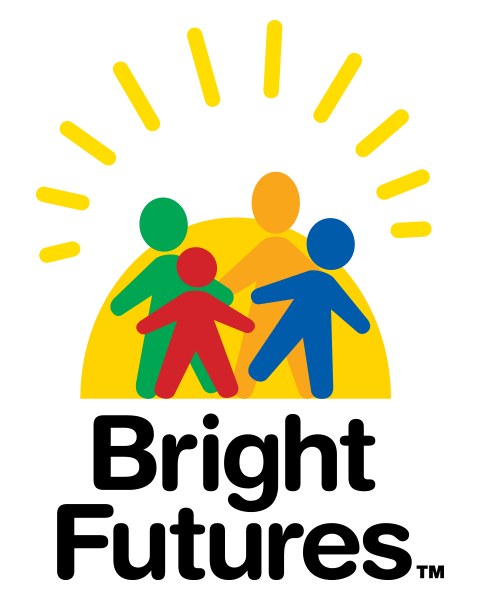Bright Futures
First Week Visit (3 to 5 Days)
Here are some suggestions from Bright Futures experts that may be of value to your family.

How Your Family is Doing
- If you are worried about your living or food situation, talk with us. Community agencies and programs such as WIC and SNAP can also provide information and assistance.
- Tobacco-free spaces keep children healthy. Don’t smoke or use e-cigarettes. Keep your home and car smoke-free.
- Take help from family and friends.
Feeding Your Baby
- Feed your baby only breast milk or iron-fortified formula until he is about
6 months old. - Feed your baby when he is hungry. Look for him to
◦ Put his hand to his mouth.
◦ Suck or root.
◦ Fuss. - Stop feeding when you see your baby is full. You can tell when he
◦ Turns away
◦ Closes his mouth
◦ Relaxes his arms and hands - Know that your baby is getting enough to eat if he has more than 5 wet diapers and at least 3 soft stools per day and is gaining weight appropriately.
- Hold your baby so you can look at each other while you feed him.
- Always hold the bottle. Never prop it.
If Breastfeeding
- Feed your baby on demand. Expect at least 8 to 12 feedings per day.
- A lactation consultant can give you information and support on how to breastfeed your baby and make you more comfortable.
- Begin giving your baby vitamin D drops (400 IU a day).
- Continue your prenatal vitamin with iron.
- Eat a healthy diet; avoid fish high in mercury.
How You Are Feeling
- Try to sleep or rest when your baby sleeps.
- Spend time with your other children.
- Keep up routines to help your family adjust to the new baby.
Baby Care
- Sing, talk, and read to your baby; avoid TV and digital media.
- Help your baby wake for feeding by patting her, changing her diaper, and undressing her.
- Calm your baby by stroking her head or gently rocking her.
- Never hit or shake your baby.
- Take your baby’s temperature with a rectal thermometer, not by ear or skin; a fever is
a rectal temperature of 100.4°F/38.0°C or higher. Call us anytime if you have questions or concerns. - Plan for emergencies: have a first aid kit, take first aid and infant CPR classes, and make a list of phone numbers.
- Wash your hands often.
- Avoid crowds and keep others from touching your baby without clean hands.
- Avoid sun exposure.
Helpful Resources: Smoking Quit Line: 800-784-8669
Information About Car Safety Seats: www.safercar.gov/parents | Toll-free Auto Safety Hotline: 888-327-4236
Safety
- Use a rear-facing–only car safety seat in the back seat of all vehicles.
- Make sure your baby always stays in his car safety seat during travel. If he becomes fussy or needs to feed, stop the vehicle and take him out of his seat.
- Your baby’s safety depends on you. Always wear your lap and shoulder seat belt. Never drive after drinking alcohol or using drugs. Never text or use a cell phone while driving.
- Never leave your baby in the car alone. Start habits that prevent you from ever forgetting your baby in the car, such as putting your cell phone in the back seat.
- Always put your baby to sleep on his back in his own crib, not your bed.
◦ Your baby should sleep in your room until he is at least 6 months old.
◦ Make sure your baby’s crib or sleep surface meets the most recent
safety guidelines. - If you choose to use a mesh playpen, get one made after February 28, 2013.
- Swaddling is not safe for sleeping. It may be used to calm your baby when
he is awake.
▪ Prevent scalds or burns. Don’t drink hot liquids while holding your baby.
▪ Prevent tap water burns. Set the water heater so the temperature at the faucet is at or below 120°F /49°C.
What to Expect at Your Child's 2 Week Visit
We will talk about
- Taking care of your baby, your family, and yourself
- Promoting your health and recovery
- Feeding your baby and watching her grow
- Caring for and protecting your baby
- Keeping your baby safe at home and in the car
Consistent with Bright Futures: Guidelines for Health Supervision
of Infants, Children, and Adolescents, 4th Edition
For more information, go to https://brightfutures.aap.org.

The information contained in this handout should not be used as a substitute for the medical care and advice of your pediatrician. There may be variations in treatment that your pediatrician may recommend based on individual facts and circumstances. Original handout included as part of the Bright Futures Tool and Resource Kit, 2nd Edition.
Inclusion in this handout does not imply an endorsement by the American Academy of Pediatrics (AAP). The AAP is not responsible for the content of the resources mentioned in this handout. Web site addresses are as current as possible but may change at any time.
The American Academy of Pediatrics (AAP) does not review or endorse any modifications made to this handout and in no event shall the AAP be liable for any such changes.
© 2019 American Academy of Pediatrics. All rights reserved.
